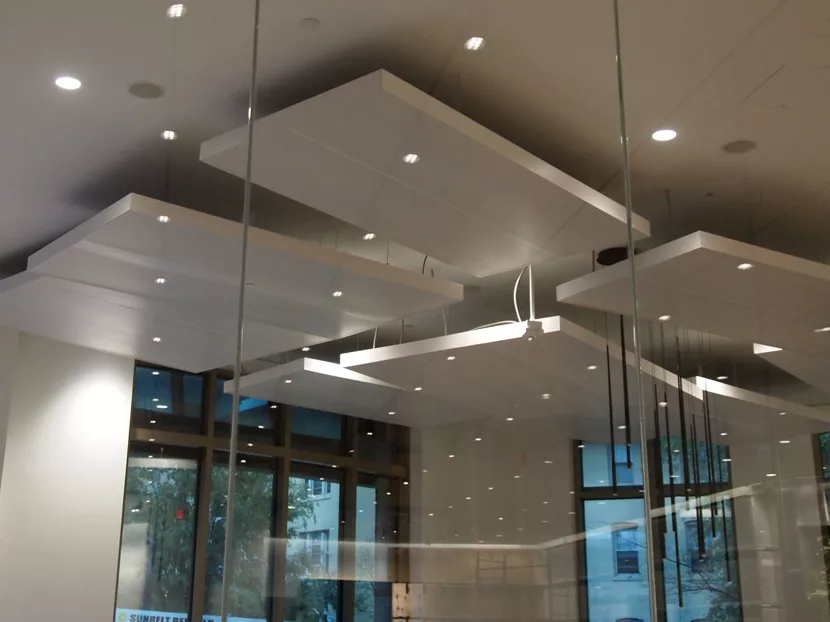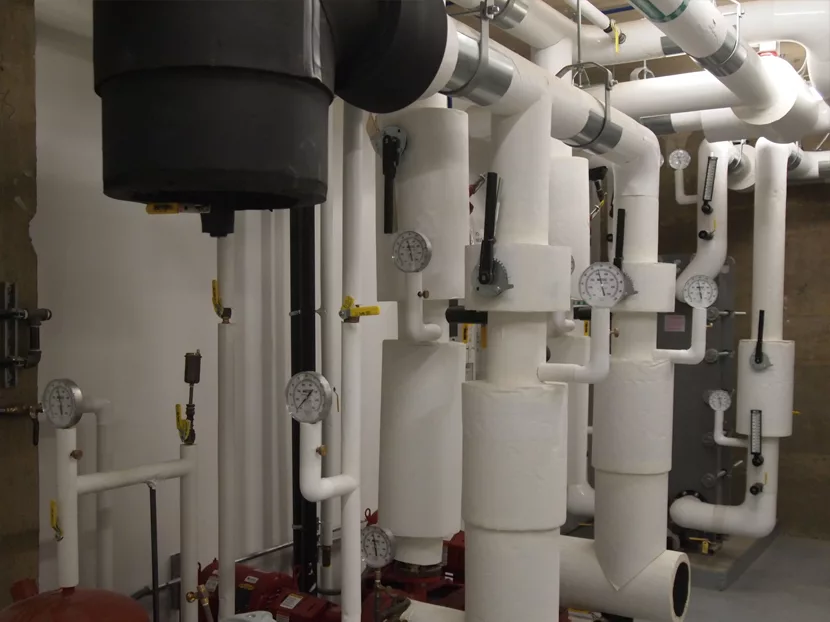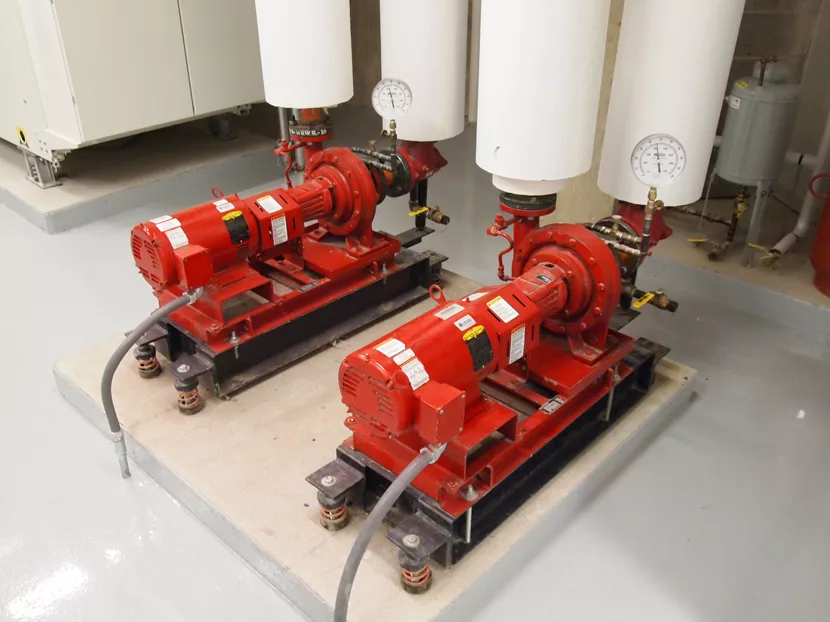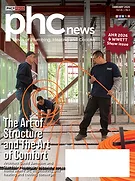Shapiro & Duncan recently implemented renovations that will allow the American Geophysical Union headquarters in Washington D.C. to be the District’s first building to generate more energy than it uses.
According to its website, the AGU “is dedicated to the furtherance of the Earth and space sciences, and to communicating our science’s ability to benefit humanity.”
With more than 62,000 members from 144 countries, the AGU decided to demonstrate this dedication in the renovation of its 25-year-old building.
As PHC News columnist BF Nagy pointed out in a recent column: “Given that the organization studies the earth, reports on climate change and makes recommendations on clean energy, its leadership felt that the envelope and old equipment in its home should be replaced with contemporary sustainable systems, to signal its commitment to a new and different world. The original goal was a net-zero energy building, but Building Services Manager Matthew Boyd believes the final metrics will reveal the project to be energy positive.”
AGU’s design focused on four key engineering principles—reduction, reclamation, absorption, and generation. Within these four principles, more than 50 different strategies were individually researched and tested, with the project team ultimately selecting the key 24 strategies.
Mechanical systems, including HVAC and plumbing equipment, use a substantial amount of energy. Reducing energy usage of these mechanical systems is essential to helping the building achieve net zero status and beyond.
Challenges
Regular air-conditioning systems reject heat in several ways, but primarily remove heat to the outside through air or water. In order to save money, as well as enhance energy efficiency, a municipal waste heat exchanger (MWHE) was specified in the AGU renovation design to reject heat from the building and facilitate the air-conditioning process whenever cooling is required.
A municipal sewer heat exchange system is an innovative way to recover thermal energy from wastewater.
So, instead of using a fan to blow hot air outside, or water through a cooling tower, a MWHE uses water in the sewer system where the water temperature usually ranges from the upper 40s to the mid-50s. This is actually the ideal temperature range for both cooling and heating purposes. The process works for heating because, in winter, sewage water contains heat.
Close beneath the street on Florida Avenue runs a large combined storm and sanitary sewer line built in the 1890s. The municipal sewer heat exchange system will tap into the sewer line and divert wastewater to a settling tank located outside of the building. Water from the settling tank will then be circulated inside the building to an exchange system that will extract energy from the water for heating and cooling before the water is returned to the sanitary sewer system.
During periods of the year when the sewer temperatures are cool, the building’s radiant cooling system will operate in “free cooling” mode using the water from the sewer heat exchange system allowing the building’s chiller to be turned off. This eliminates the need for a cooling tower on the roof and a substantial quantity of fresh potable water is saved.
A first in U.S.
This is the first time MWHE technology will be used in a commercial building project in the United States.
A wet well, 30 feet tall and nine feet wide, is where sewage water is brought into the heat exchanger using a pump and filtration equipment to remove solids. Again, this is another “first” done in a U.S. commercial building renovation.
Bringing it all together, is a water-to-water heat pump that produces hot and chilled water to heat and cool the building. This type of heat pump relies on a closed glycol loop with the MWHE to either reject or absorb heat from the sewage loop. This is how they work together to heat and cool the building.
S&D’s equipment in the wet well pulls in sewer water, filters out the solids, pumps the sewer water into the building, the heat exchanger inside the building accepts this water, exchanges heat into a condenser loop feeding the water to water heat pump, then sends the wastewater back out to the well, which pushes it into the sewer.
Radiant cooling
Meanwhile, the radiant ceiling system starts with approximately 1,000 metal-based, cooling-only radiant panels which were supplied by a German manufacturer. These are mounted on a hanging grid, much like acoustical ceiling panels. In addition, 200 cooling-only radiant ceiling panels are embedded in the ceilings and are not visible.
By circulating chilled water through a network of pipes installed in the ceiling’s 2-by-2 or 2-by-4 panels, the hydronic cooling system will help maintain spaces at even, comfortable temperatures using less energy than a traditional forced-air system. The cooled ceiling surface panels will evenly absorb heat energy transferred from people, lights, and equipment. Heat and ventilation air will be provided by a dedicated outdoor air system (DOAS) that will work in conjunction with the radiant cooling system for ventilation, pressurization, and humidity control.
In addition, air is distributed throughout the building by 100 variable air volume (VAV) boxes.
Another innovative – and somewhat unusual – element of the building mechanical system is a “hy-phy” wall, a living plant wall that is responsible for funneling all of the DOAS exhaust air from the building.
The green wall works with a building’s HVAC system to reduce energy loads and improve indoor air quality. Typically, buildings are ventilated with air sourced from outside and must be heated in the winter and cooled in the summer, which can represent more than 30 percent of the energy consumed by a building.
The green wall is an engineered system that will allow indoor air that is already at the right temperature and humidity to be circulated through the root system of live plants where it will be cleaned and filtered of CO2 before passing back into the building. Because the plants’ roots are submerged in water, instead of being buried in soil, the plants’ air-cleaning capacity increases by 200 to 300 percent and is extremely effective at removing large particles and oxygenating the air.
By exhausting interior air through the hy-phy wall, the living plants remove CO2 and other pollutants – which means the DOAS unit doesn’t need to spend extra energy to temper outside air. It can simply use return air and send it back to the building.
A final “green” feature of this top-to-bottom building renovation is the rainwater harvesting system, which collects and filters rainwater. A water reclamation cistern will collect rainwater from the roof, as well as condensate water from the dedicated outdoor air system, and will filter, chemically treat, and condition the water. This filtered rainwater is then used to irrigate plants as well as to flush toilets and urinals.
Specific challenges
Above and beyond the fact that the AGU project is the first time that all of the above advanced, innovative technologies were integrated in one U.S. commercial structure, there were several specific challenges related to design and installation.
Our first major challenge related to coordination. The existing structure retained its metal decks and concrete floors, as well as structural steel beams and columns, but the engineering drawings did not reflect the actual beam conditions.
To facilitate coordination and devise a solution for routing ductwork and piping, our Virtual Design and Coordination team used our advanced Building Information Modeling system to create 3D models of the true beam conditions (including openings) on all six floors. Guided by these models, the engineers were able to go back and redo the drawings.
Another big challenge was installing the pump equipment inside the wet well. Not only was this the first time our company had worked with this German-manufactured brand of filtration and pumping equipment, but this type of mechanical structure had never before been installed and aligned in a 30-foot x 9-foot underground concrete well. Getting it right required careful sequencing of the work from the site utility contractor.
Our team solved these challenges by getting the different trades together that were responsible for all of the components, researching answers to the problems and then working together to overcome sequencing challenges of installation.
For example, in the wet well, instead of relying solely on engineering drawings to determine proper placement of taps to and from the sewer system, and to and from the building, our field team and the utility contractor’s team performed actual field surveys of the existing infrastructure. This is how we ensured proper coordination of all line locations – two lines from the well to the building and two lines from the well to the sewer.
Our team also went above and beyond the usual scope of a mechanical system design and installation project by taking it upon ourselves to 3D remodel the structural steel beams.
Installation of the radiant heating panels went smoothly because we knew what to expect based on our prior successful first-time experience with this brand-new technology in 2015-16, during construction of the new American University Washington College of Law campus in Northwest Washington, D.C.
Our team overcame scheduling difficulties. We succeeded in coordinating and installing cutting-edge, foreign-made wet well equipment in a 30-foot-deep well – something that had never been done before in the United States. We demonstrated that we could pull sewage water from the D.C. water system into the building, use it for heating and cooling purposes, and then send it back into the sewer system.
When the time came to cool the building during the summer of 2018, the entire system was functional and operational. The 1,200 sensible-only radiant heating panels operated as designed and the DOAS component maintained low humidity levels inside the building.







